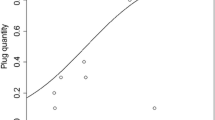Abstract
In the female grasshopper Gomphocerus rufus mating elicits ‘secondary defense’ which makes remating impossible. The behavioral change is caused by the liquid white secretions, proteins of less than 90 kD, which are produced by the white tubuli of the male's accessory glands. Experimental injection of the white secretions directly into the spermathecal duct of receptive virgins provokes ‘secondary defense’ instantly whereas sperm transfer had no such effect. ‘Secondary defense’ is also released by eggs entering the oviducts and excerting pressure against the oviductal walls on their way to oviposition.
Similar content being viewed by others
References
Chen PS, Stumm-Zollinger E, Aigaki T, Balmer J, Bienz M, Bohla P (1988) A male accessory gland peptide that regulates reproductive behavior of female Drosophila melanogaster. Cell 54 (3): 291–298
Friedel T, Gillott C (1977) Contribution of male-produced proteins to vitellogenesis in Malanoplus sanguinipes. J Insect Physiol. 23: 145–151
Giebultowicz JM, Raina AK, Ridgway RL (1991) Role of the spermatheca in the termination of sex pheromone production in mated gypsy moth females. In: Hrdy I (ed) Proc Insect Chem Ecol, Tabor 1990, pp 101–104
Hartmann R (1970) Experimentelle und histologische Untersuchungen der Spermatophorenbildung bei der Feldheuschrecke Gomphocerus rufus L. (Orthoptera, Acrididae). Z Morph Tiere 68: 140–176
Hartmann R (1971) Der Einfluß endokriner Faktoren auf die män nlichen Akzessorischen Drüsen und die Ovarien bei der Keulenheuschrecke Gomphocerus rufus L. (Orthoptera, Acrididae). Z Vergl Physiol 74: 190–216
Hartmann R (1978) The juvenile hormone-carrier in the haemolymph of the acridine grasshopper Gomphocerus rufus L.: Blocking of the juvenile hormone's action by means of repeated injections of an antibody to the carrier. Roux's Arch Dev Biol 184: 301–324
Hartmann R, Loher W (1974) Control of sexual behavior pattern ‘secondary defence’ in the female grasshopper Chorthippus curtipennis. J Insect Physiol 20: 1713–1728
Heady SE (1993) Factors affecting female sexual receptivity in the planthopper Prokelisia dolus. Physiol Entomol 18 (3): 263–270
Heukeshoven J, Dernick R (1988) Improved silver staining procedure for fast staining in Phast System development unit. I. Staining of sodium dodecyl sulfate gels. Electrophoresis 9: 28–32
Hihara F (1981) Effects of the male accessory gland secretion on oviposition and remating in females of Drosophila melanogaster. Zool Mag (Tokyo) 90 (3): 307–316
Hunter-Jones P (1960) Fertilization of eggs in the desert locust by spermatozoa from successive copulations. Nature 185: 336
Jacobs W (1953) Verhaltensbiologische Studien an Feldheuschrecken. Beih. 1. Z Tierpsychol 228 pp
Kaulenas MS (1992) Insect accessory reproductive structures. Zoophysiology 31: 123–157
Laemli UK (1970) Clevage of structural proteins during the assembly of the head of bacteriophage T4. Nature 227: 680–686
Loher W (1966) Die Steuerung sexueller Verhaltensweisen und der Oocytenentwicklung bei Gomphocerus rufus L. Z Vergl Physiol 53: 277–316
Loher W, Huber F (1964) Experimentelle Untersuchungen am Sexualverhalten des Weibchens der Heuschrecke Gomphocerus rufus L. (Acrididae). J Insect Physiol 10: 13–36
Loher W, Dambach M (1989) Reproductive behavior. In: Huber F, Moore TE, Loher W (eds) Cricket Behavior and Neurobiology Cornell University Press, Ithaca and London, pp 43–82
Loher W, Huber F (1965) Nervous and endocrine control of sexual behaviour in a grasshopper (Gomphocerus rufus L.: Acrididae). Symp Soc Exp Biol 20: 381–400
Mann Th (1984) Spermatophores. Development, structure, biochemical attributes and role in the transfer of spermatozoa. Zoophysiology 15: 217 pp
Maurer HR (1971) Disc electrophoresis and related techniques of polyacrylamide gel electrophoresis 2. Auflage. Walter de Gruyter, Berlin New York
Obara Y (1982) Mate refusal hormone in the cabbage white butterfly. Naturwissenschaften 69: 551
Parker GA (1970) Sperm competition and its evolutionary consequences in the insect. Biol Rev 45: 525–567
Raina AK (1989) Male induced termination of sex pheromone production and repetivity in mated females of Heliothis zea. J Insect Physiol 35 (11): 821–826
Raina AK, Kingan TG, Giebultowicz JM (1994) Mating-induced loss of sex pheromone and sexual receptivity in insects with emphasis on Helicoverpa zea and Lymantria dispar. Arch Insect Biochem Physiol 25 (4): 317–327
Renner M (1952) Analyse des Kopulationsbereitschaft des Weibchens der Feldheuschrecke Euthysthyra brachyptera Ocsk in ihrer Abhängigkeit vom Zustand des Geschlechtsapparates. Z Tierpsychol 9: 122–154
Sugawara T (1979) Stretch reception in the bursa copulatrix of the butterfly, Pieris rapae crucivora, and its role in behavior. J Comp Physiol 130: 191–199
Sugawara T (1986) Oviposition behaviour of the cricket Teleogryllus commodus: The site of action of an oviposition-stimulating factor and the role of the nervous system. J Insect Physiol 32: 485–492
Wakler WF (1980) Sperm utilization strategies in nonsocial insects. Am Naturalist 115: 780–799
Author information
Authors and Affiliations
Rights and permissions
About this article
Cite this article
Hartmann, R., Loher, W. Control mechanisms of the behavior ‘secondary defense’ in the grasshopper Gomphocerus rufus L. (Gomphocerinae: Orthoptera). J Comp Physiol A 178, 329–336 (1996). https://doi.org/10.1007/BF00193971
Accepted:
Issue Date:
DOI: https://doi.org/10.1007/BF00193971




